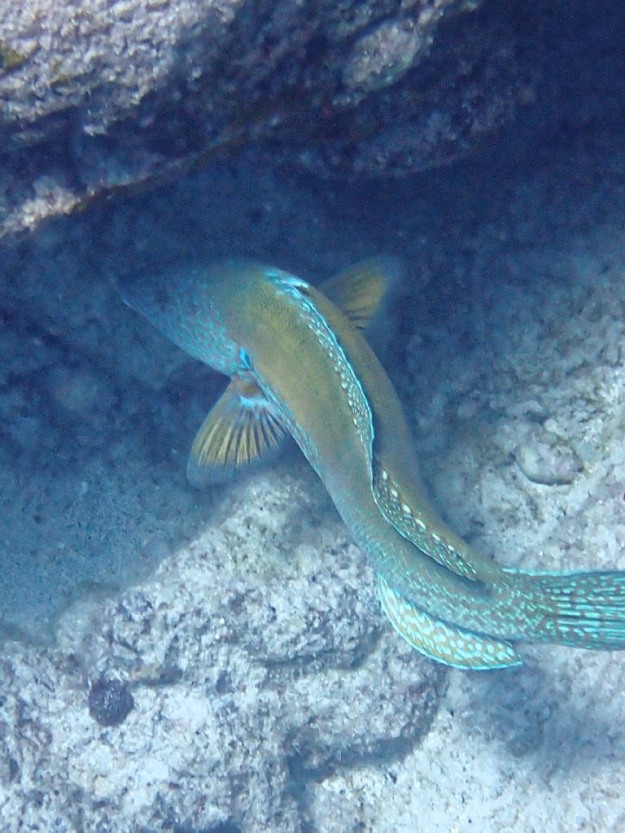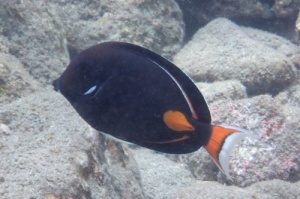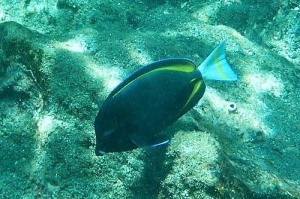I’m not a shark, either. Or a large grouper, or a manta ray. On one of my dives off Menjangan Island one fish seemed to disagree with these assertions. It was a small sharksucker, or slender remora, a near-shore species that hitches rides on large fish, turtles, even whales, using odd suction structures on its head. This particular remora decided it wanted to attach itself to me. I kept shooing it away, but it persisted for about ten minutes before giving up and swimming off. I’ve read that they can attach themselves to you securely enough that it can be difficult to remove them. I guess if you just got out of the water they’d let go pretty quickly.
Tag Archives: slender remora
A few rarities—at least for us
After snorkeling hundreds of times at Mahukona, Marla and I have gotten pretty good at quickly distinguishing resident fish from seasonal visitors, occasional visitors, and relative rarities. We’ve been lucky enough to spot three fish that fall into the last category over the last few weeks.
Yesterday we ran into a spotfin (also known as giant) porcupinefish hunkering under a ledge in about fifteen feet of water. These fish are not uncommon at Mauhukona, but when we dove down for a closer look we discovered something very unusual—the porcupine had a small sharksucker (aka slender remora) attached to its back. Remoras have evolved suction devices (modified dorsal fins) on their heads which they use to attach themselves to larger fish or other marine animals, hitching a ride and presumably feeding on scraps left by their host. Both Hoover and Stender (see the “about” section of this blog) state that these fish are rare in Hawaii, so we were very pleased see one and get a photo.

Giant porcupinefish with hitchhiking sharksucker. Hoover writes that sharksuckers are supposed to prefer sharks, but will attach to “almost anything that is going their way,” including sea turtles. You are looking at the belly of the remora, folded pelvic fins (I think) barely visible behind the head. You can also see some sort of white lesion on the porcupine’s back, just above the remora. Whether this is at all related to the presence of the remora I have no idea.
The adult male blackstripe coris is another fish described by Hoover and Stender as rare. I first saw this one in April, then again in June, and again, this time with Marla, in early July, so it has apparently been living in the vicinity. All three times the fish was in fifteen to thirty feet of water. It’s a large fish, maybe eighteen inches long, and like most larger fish at Mahukona, it was quite skittish. I was lucky enough to get a couple of photos on the June encounter, but you can see that the fish was headed for cover under a ledge as I took the shots.
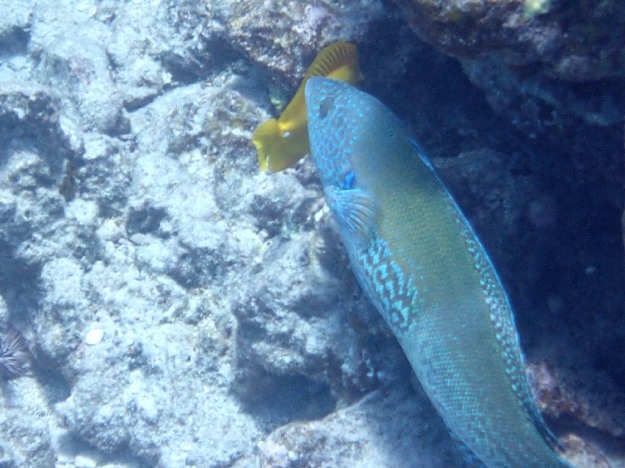
Not a very good shot, but it shows something peculiar about this individual. The wavy dark lines along the belly run predominantly horizontally. In contrast, these lines run mostly vertically in all other photos I’ve seen of this fish, including those in Hoover, Stender, and Randall. Meaningful or just normal variability?
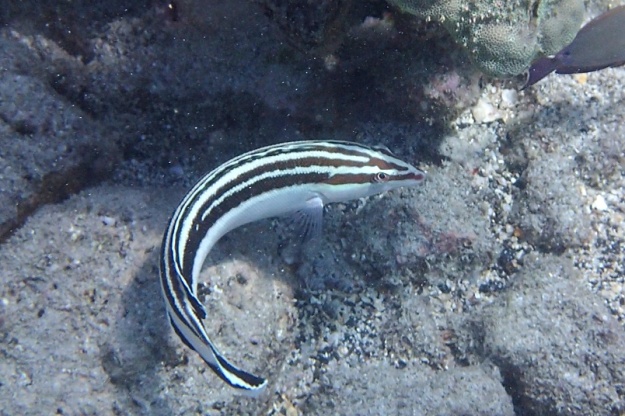
This juvenile blackstripe coris illustrates where the common name for this species comes from. The juveniles, while not very common, show up at Mauhkona fairly regularly. We occasionally see adult females, which look very much like the juveniles.
We’re so accustomed to seeing small achilles tangs and goldrim surgeonfish schooling together in shallow water around the Mahukona dock that we don’t pay them much notice. Recently, one member of the mixed school stood out. It was a hybrid between these closely related surgeonfish. These hybrids are not extraordinarily rare, but interspecific hybrids are by definition uncommon, since any species that regularly interbreeds with another species will soon loose its identity as a separate species. Hoover states that these hybrids occur “occasionally.” Anyway, I was pretty excited to spot the hybrid and chased it around, weaving among swimming children in shallow, rather cloudy water to get some marginal photos.
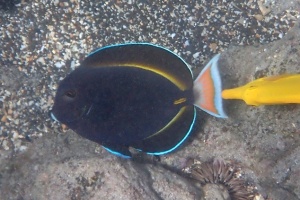
The achilles-goldrim hybrid with an unfortunately positioned yellow tang. It looks a lot like a goldrim, but the tail is definitely achilles.





